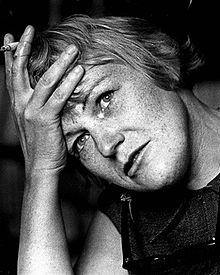Sonja Åkesson | |
|---|---|
 Sonja Åkesson, 1968. | |
| Born | 19 April 1926 Buttle, Gotland |
| Died | 5 May 1977 (aged 51) |
| Occupation | Poet |
| Known for | Feminism |
Sonja Åkesson (19 April 1926 – 5 May 1977) was a Swedish poet, writer, and artist born in Buttle, Gotland.[1][2]
Life
Sonja Åkesson first discovered her talent for writing at 28 after moving to Stockholm, after her divorce from Nils Westberg, a carpenter. They had two children at the time of the divorce and Sonja was expecting a baby (not her husband’s). The baby died from leukemia at the age of two.[1]
In 1956, Sonja married Bo Holmberg and had her fourth child, Mikael.[1] The following year she published her first collection of poems: Situationer ("Situations"). In 1963 she became a household name in Sweden after publishing Husfrid. She became known for her distinct style of writing, describing daily life and commenting on society.[3] The feminist movement embraced Åkesson's work and often cited it. The most famous of her poems is probably "äktenskapsfrågan" (the question of marriage).[2] This is often referred to as "vara vit mans slav" (to be the slave of a white man) as this is repeated throughout the poem.
After nine years of marriage, she divorced Bo Holmberg in 1965. She married Jarl Hammarberg, a Swedish artist and poet, and gave birth to her fifth child, Gertie.[1] Sonja Åkesson moved to Halmstad in the 1970s after suffering from mental illness, and in 1977 she died from liver cancer.[1]
Works
Her works include:[2]
Poetry
- Situationer (1957)
- Glasveranda (1959)
- Husfrid (1963)
- Pris (1968)
- Sagan om Siv (1974)
Prose
- Skvallerspegel (1960)
- Leva livet (1961)
- Efter balen (1962)
Her manuscripts and other papers are held within the Women’s History Collections, Gothenburg University, Sweden.[4]
References
- ^ a b c d e "Sonja Åkesson 1926–1977". Retrieved 1 May 2011.
- ^ a b c Hans-Erik Johannesson. "Sonja Akesson – Poems and Biography". Poetry Connection. Archived from the original on 26 August 2011. Retrieved 1 May 2011.
- ^ Håkan Sandgren (11 January 2007). Nordic Women, Symbiotic Poetry (PDF). p. 661. Retrieved 1 May 2011.
- ^ Berith Backlund (8 August 2008). "Women's History Collections, Gothenburg University, Sweden – Activities 2006–2008" (PDF). Archived from the original (PDF) on 21 July 2011. Retrieved 1 May 2011.
Further reading
- Sonja Bertha Maria Åkesson at Svenskt kvinnobiografiskt lexikon
External links